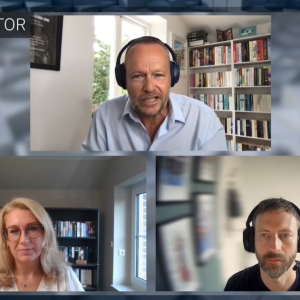Q. Adoption of RFID in the US has been spurred by Wal-Mart and US Department of Defense mandates, but how much of your growth is now driven by closed-loop applications – whereby the tracked objects never leave the company?
A. It’s great that Wal-Mart and the DoD had the fortitude and the vision to kick start the market. I think everyone should be grateful they did that. And it’s still very big and stable, and we’re happy to participate in the mandate side of the market. And the DoD, from our recent experience, is heating up – it seems to be getting quite a bit hotter than the retail side of the market. We just received a large order in past couple of weeks from the DoD.
But to give you an idea, and without giving you a percentage, in our fiscal ’07 that ended September 30 we had three all-time record quarters in terms of revenue and two of those three quarters had minimal mandate business in them. So we have absolutely seen a large amount of our business being driven by closed loop applications. Certainly, that seems to be the hot area.
Q. Is this a shift in strategy for Alien, which historically has been a leader in mandate business?
A. To some degree. When I came in, not because I had great wisdom about closed-loop applications necessarily, but looking at our strategy I thought perhaps it was a little too high risk and I thought we could alternate with what we’re doing with other markets and segments. So we did do that. But we are not retreating one inch from the mandate business. It is growing despite what some articles may say, especially in the DoD system. It’s really more an augmentation for our strategy rather than a shift away from anything.
Q. When do you expect closed-loop application revenue to surpass mandate-driven revenue?
A. Frankly, I think is going to be a classic leapfrog event. Certainly, the mandate drove most of the revenue. I think we’re seeing a phenomenon now where closed-loop revenue is surpassing today on a worldwide basis the mandate-driven business. I wouldn’t be surprised to see another leapfrog event at some point in time when the mandate business…matures. The mandates started the business but ultimately there has to be a reason to do it. I think what has been called mandate business will kick in. I think open-loop but not mandated business will take a major leap in the next couple of years.
Companies in that segment already today are seeing examples of it and I think it will take hold. And then the numbers start to play into it; it’s in such high volume it will have an impact on our business. That’s why I emphasize we are not walking away from mandate. We are supplementing or augmenting with closed loop.
Q. In what industries are you seeing the most growth in closed loop?
A. The DoD estimates there are over 100 million high-end traceable reusable assets worth over $5,000 each; so it’s still a huge market.
Other areas that seem to be taking off: one is airports — hundreds of millions of bag gages are checked in every day in airports around the world. And the nature of what RFID can do makes it a compelling solution for that. That will extend to cargo. The auto industry is another area. Each large industrial plant has millions of tools that need to be accounted for.
Also, paper and documents. The courthouses have all sorts of needs for tracking documents, which may have to be kept forever depending on the type of evidence. That goes for banks too. Banks need seven traceable documents for each account holder that they’re legally bound to store and document.
Also, vendors selling any type of replaceable pieces, for example the large printer and cartridge manufactures. Pharma is another one. I think the key message is, it is broad and the uses are actually pretty creative across those broad segments.
One thing we’re observing is that adoption of RFID is not just an enterprise phenomenon. There are a lot of small and mid-sized companies implementing it, especially since the cost of both readers and tags are at a level today that they’re implementing it to favor their business. An example, used at the EPCglobal conference last week, was a sushi restaurant company that had three Kaiten-zushi restaurants in Seattle. They used to use color-coded plates, but now are using RFID to track the sushi automatically as it goes around on the conveyor belts. The benefits were not just that they could bill people correctly, but chefs could see data in real time on what people were ordering and what was popular during certain times…all sorts of information. That saved their spoilage tremendously.
Q. What has stymied the adoption of RFID in other industries?
A. I think the biggest thing is two fold. First and foremost it is simply imagination. Some companies just haven’t stopped to think how this technology could help them.
An example, and this has just started happening, is in the arena of mining. There are companies that are placing tags where they’re doing explosive mining. They put the tags on the surface and in grids around the field where they’re going to blow up the dirt. The tags end up with the dirt and are put on conveyer belts. When the conveyer belts rolls by the readers they then know where that dirt came from and see where the riches ore is.
Some of the applications, once you see what they’re doing you slap your forehead and say, That’s so obvious.
Second is just education. That’s a tremendous driver. We’re one of the few companies directly involved in RFID that has solutions not just in tags and readers but also services. And the services side is certainly making inroads and helping drive adoption. But understanding what RFID is and isn’t key.
Q. The RFID tag pricing market is known for being cut throat. To help it become one the biggest tag vendors, I understand Alien, in the past, sold its newer Gen 2 RFID tags at below cost. Is that still the case? And can you talk a bit about the pricing market in general.
A. We feel that we are fairly uniquely positioned relative to this. One reason is we have different tags for different purposes. . but at the heart of each one of those is our HIGGS chips. It is by far the best performing chip on the market and yet we know it’s the lowest cost.
We have patented technology on the Fluidic Self-Assembly process — so we can actually get many more die off an 8-inch [silicon] wafer than others can. Because Alien’s FSA, the company can catch each of those die off the wafer means the distance of the die can be much closer. We get 20% to 25% more die per wafer, so we start out with a cost advantage. So we think an aggressive market where cost is an issue, as well as a performance, plays right into our hands. We welcome that type of activity because it spurs the market and adoption.
Having said that, pricing has been quite stable for over 12 months. I think as these closed loop solutions take place with very big customers you will see increased pricing competition.
We have a positive variable margin. The more we sell the more money we make. We are not losing money by increasing the volume of our product. We made a big investment in having capacity and so you need to reach volume before you absorb that capacity. We’re very happy with our financial model today. In fiscal ’07 we started making money and making more money the more we sold versus the opposite.
Q. Is an IPO still on the cards?
A. We don’t discuss IPOs per se. I think, and this is my personal opinion, that it was good for the company that they made the decision to pull back on the IPO because I think the company might not be ready for that. The goal of alien is not to produce an IPO, the goal for us is to build a great company…It might be a logical event for us to raise capital in the market so that we can be a bigger great company.
Q. Are you seeking venture capital?
A. We raised a round of funding that we are just in the throes of completing. It’s a round that is virtually completed. It has not yet been announced. Earlier this year we announced we raised $33m. We feel very good where we are right now in terms of funding. If you ask what I stay up late at night thinking about, that is certainly not it.






